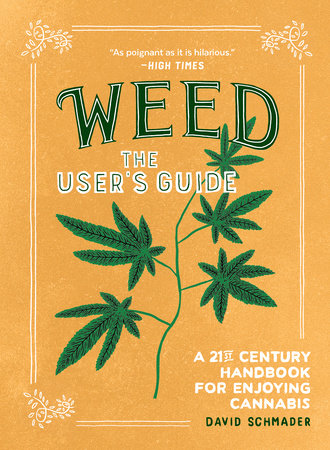Introduction
The life-enhancing potential of marijuana first made itself known to me when I was nineteen. A group of friends and I were headed out to a Mexican restaurant, and en route one friend whipped out a joint and passed it around. I’d smoked weed before and enjoyed it. I’d eaten Mexican food before and enjoyed it. But the combination of the two was revelatory. One of weed’s great powers is sensory enhancement, and my sensory-enhanced encounter with a nothing-fancy enchilada plate was a full-immersion. Technicolor opera starring pico de gallo–soaked rice and delicious bits of charred cheese around the edges. When I was done, I felt like I’d just had a short face-to-face with God in my mouth.
This enchilada epiphany led me to further investigation of weed’s power to enrich sensory perception and facilitate immersive engagement with the world. I was thrilled to find it worked with music (I spent what felt like hours swimming around in the space between notes on Cowboy Junkies’ languorous The Trinity Session), comedy (ditto sob-laughing through compulsive replays of 30 Rock’s “Werewolf Bar Mitzvah”), and conversation.
Still, the fact remained that all these seriously enriching pleasures were forbidden—banned by law and disparaged by society, the majority of which lazily adhered to the stereotype of potheads as basement-dwelling burnouts on the level of the fictional Cheech & Chong.
But what about all the high-functioning, life-loving adults—doctors, lawyers, engineers, entrepreneurs, authors, parents—who comprise the vast majority of weed smokers I know? The reality of responsible adult marijuana use is a fact of life that’s ever more apparent, thanks in large part to citizen-driven efforts to reclassify, decriminalize, and legalize marijuana. This book is a guide for all those interested in exploring the wide, wonderful, post-“War on Drugs”-terror-hyperbole world of marijuana.
That all sounds great but perhaps you’re wondering: Does weed require a “user’s guide”? Aren’t the basic facts known to every middle-school rebel puffing behind a Dumpster?
Yes and no. (But mostly no.)
Yes, marijuana’s ability to produce psychoactive effects in human users is common knowledge. But beyond this fact lies a world of nuance and discernment that I will map in this book—synthesizing information from the existing pool of marijuana wisdom and offering myself up as an experienced test subject and tour guide. (Another reason for a user’s guide is that today’s concentrated marijuana products are a far cry from the grassy stuff folks might’ve smoked at Woodstock or in the ’80s in college—a fact that makes even past personal experience an unfortunately unreliable guide to twenty-first-century weed.)
In this book, you’ll find all you need to know to about the current state of recreational marijuana, from methods of ingestion and varieties of effects to edible recipes and tips for maximizing your marijuana experience.
What you won’t find in this book is reckless encouragement to smoke marijuana. Even among people who love it, experiences of being high differ widely, and there are tons of folks who just don’t enjoy the sensations marijuana offers. To these people, I offer my sympathies, my support, and Chapter 7: If You’re High and Don’t Like It.
To everyone else, a final bit of wisdom from Stephen Colbert, who delivered this gem at the end of a scared-straight drug lecture on Strangers with Candy: “All I’m saying is, if you still want to smoke pot, then be prepared to spend a lot of
time laughing with your friends.”
Copyright © 2023 by Schmader, David. All rights reserved. No part of this excerpt may be reproduced or reprinted without permission in writing from the publisher.




















